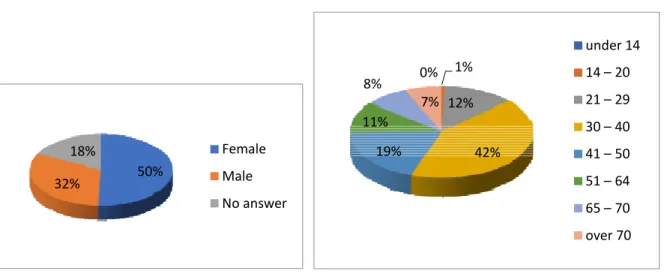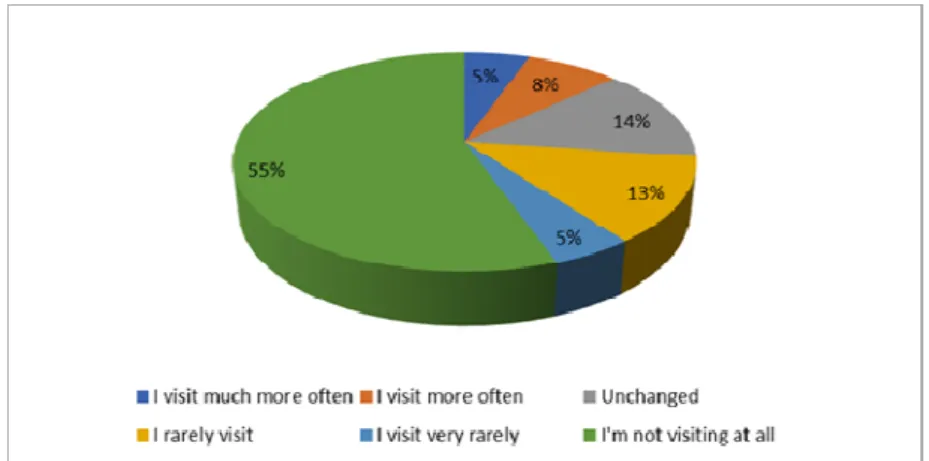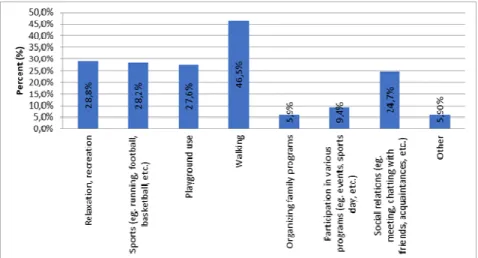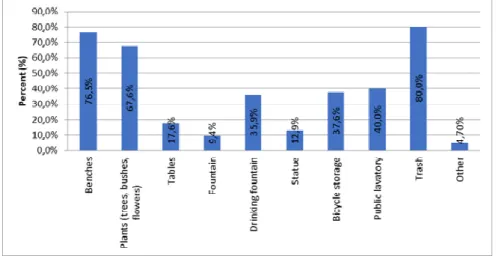The Effect of the Pandemic of the Use of Public Spaces in Hungary László Jóna
(Dr László Jóna, Széchenyi István University, Faculty of Architecture, Civil Engineering and Transport Sciences, Department of Transport, Hungary, 9026 Győr, Egyetem tér 1., jona.laszlo@sze.hu; Centre for Economic and Regional Studies Institute for
Regional StudiesWest-Hungarian Research Department, Hungary 9022 Győr, Liszt Ferenc utca 10., jona.laszlo@krtk.hu)
1 ABSTRACT
The first wave of the coronavirus epidemic in Hungary held in 2020 from March until April. During this period the restrictions not only to the shops opening hours came into force but also for the use of public spaces. The most settlements in Hungary had closed their public spaces and parks from the local population, thus preventing the mass spread of the epidemic. However the experiences have showed that most people against the restrictions has used in the same way actively the local public spaces as before. Therefore the research presents how the people has used the public spaces before and after the coronaviros epidemic in Hungary. And when will they use them again and how often after the pass of the epidemic. Besides that what they expect from the public spaces after the pass of the coronavirus epidemic.
Keywords: survey, hungary, parks, public spaces, coronavirus 2 INTRODUCTION
The first wave of the coronavirus epidemic (COVID-19) in Hungary lasted from March to April in 2020, which, as in all countries, had a serious impact on all areas of life, including the use of public spaces. Since the virus appeared in Hungary, fewer and fewer people have visited the city's public spaces and parks, which was then officially restricted by a government decree in March. Namely the 5th paragraphs of the 71/2020.
(III. 27.) government decree from the curfew following its publication has pointed out that “Individual recreational sports activities, recreational pedestrian traffic on the outskirts and in the interior of settlements – preferably in green areas – can be carried out alone or together with people living in the same household, with a distance of at least 1.5 meters from others.” Then in most settlements, local governments closed public spaces and parks to the public, thus preventing the mass spread of the coronavirus epidemic.
However, based on experience and news, many have actively used the local public spaces in most municipalities despite their limitations. But it was also possible to hear that families from other parts of the city or settlements moved to the given park or square to relax and have fun. Therefore the aim of the study was to explore how the use of public spaces in Hungary has changed since the outbreak of COVID-19 epidemic. And on the other hand, how can public spaces and parks be made attractive again to those who have not visited them at all because of the coronavirus after the epidemic has passed. Because national and international researches has proved that public spaces, which are especially true for cities and towns, play a significant role in keeping settlements livable for the local population. (Madden, 2008; Thompson, 2002). It is no coincidence that in many Western European countries recognizing this, they embarked on a serious public space development program, which in most cases was coupled with green space development. (Ghel, 2014) Because green areas, similar to the squares and parks, have the same impact on the livability and sustainability of a given settlement. (Anguluri–Narayanan, 2017) Therefore, in addition to the changes in the use of public spaces and parks in Hungary, it was also studied what the population would like to see in these public spaces. What kind of tools, street furniture, should they have and how important is the size of the green spaces.
3 BACKGROUND OF ONLINE SURVEY RESPONDENTS
The online survey ran from April 26 to May 16, 2020, and was shared via email outside of a popular social site. A total of 287 people started filling in the questionnaire, which was eventually completed by 170 people, so only the fully completed 170 questionnaires were included in the current processing.
In terms of gender, 50% of respondents were women 32% men and 18% did not answer this question (Fig.1.)
32% 50%
18% Female
Male No answer
0% 1%
12%
19% 42%
11%
8%
7%
under 14 14 – 20 21 – 29 30 – 40 41 – 50 51 – 64 65 – 70 over 70
Fig. 1 (left): Gender of survey participants. Fig. 2 (right): Distribution of respondents by age group
In terms of age distribution, most people completed the questionnaire between the ages of 30 and 40 (42%), followed by those between the ages of 41 and 50 (19%). The other age groups represented less than 15% in the survey. Between the age 21 and 29 13%, between the age 51 and 64 11%, between the age 65 and 70 8%
and finally the age over 70 7% completed the questionnaire. Between the age 14 and 20 only 1 person completed the questionnaire and there were no respondents under the age 14 (Fig. 2.).
In terms of the highest educational attainment, almost half of the respondents (46%) had a university degree (MA, MSc) and almost a quarter (24%) had a college degree (BA, BSc). High school degree had 20%, and vocational training or vocational school 4% of the questionnaire respondents. The other category was marked by a total of 9 people (5%) where almost without exception the doctoral degree (PhD) has been specified (Fig. 3.)
Fig. 3.: The highest educational attainment rate of respondents
Fig.4.: Occupation of respondents
Slightly more than half (52%) of the respondents were employed as subordinates and 14% were retired (Fig.
4). The other categories were selected by less than 10% of the respondents, so 9% were employed in senior positions, 7% were entrepreneurs, 6% were in maternity leave payment or child benefit, 5% were students
and 2% were unemployed. The other category was marked by a total of 8 people, where several gave their profession (eg. settlement planner), two wrote that they were students and two were both students and entrepreneurs.
4 USE OF PUBLIC SPACES BEFORE THE OUTBREAK OF COVID-19 EPIDEMIC
From the answers it turned out clearly that most people (77%) live within 10 minutes from the park or square they visit most often. Within this, primarily less than 5 minutes 37%, 5 minutes 19%, and 6-10 minutes 21%.
Only 11% marked a distance of 11 and 15 minutes, and only 6% marked a distance of 16-20 minutes. More than 21 minutes distance were marked by 5 of respondents (Fig. 5.). All of this has confirmed previous research that people primarily like to visit the public space closest to where they live. (Jóna, 2016)
Fig. 5.: Time availability of the most visited public space
x
Fig. 6.: Frequency of visits to public spaces
In the period before the outbreak of the epidemic, the number of visitors to the squares and parks can be said that more than a quarter of the respondents (30%) visited the nearest one several times a week (Fig. 6). Daily 12% and weekly 19% has visited its favourite public space. However, it is important to highlight that 22% of the respondents of the questionnaire has moved out for less than a month. The rates of the biweekly (9%) and monthly (8%) visitor rates didn’t even reach 10%.
29,4% 22,9% 28,2% 47,1% 5,3% 10,6% 22,4% 8,80%
0,0%
10,0%
20,0%
30,0%
40,0%
50,0%
Relaxation, recr eation Sports (eg. running, footb… Playground use Walking Organizing family programs Participation in various … Other
Percent (%)
Fig. 7.: The purpose of the use of squares and parks before the coronavirus outbreak
To the question what purpose the respondents used the space or park they visited most often, most indicated walking (47.1%), followed by relaxtion, recreation (29.4%) (Fig. 7). Playground use (28.2%) received the third highest number of markings, which was followed by sports (eg. running, football, basketball, etc.) (22.9%) and social relations (eg. meeting, chatting with friends, acquaintances, etc.) (22.4%). Participation in various programs (eg events, sports days, etc.) was supported by just over 10%, while the organization of family programs was supported by only 5.3%. The other category was chosen by 8.8%, where more people wrote that they visited the nearby community space for dog walking. But many also wrote that they had just passed through it or that they hadn’t been visited for any purpose.
5 USE OF PUBLIC SPACES SINCE THE OUTBREAK OF COVID-19
One of the key questions of the survey was to explore how the outbreak of the coronavirus epidemic and the restrictions imposed affected the willingness to visit public spaces. Form the answers it turned out clearly that 54% of the respondents did not visit their favorite square or park since the virus appeared, but 46% still visited it with varying frequency (Fig.8). Within this, 14% several times a week, 11% weekly, 6% daily, 5%
biweekly, 2% monthly, and 8% less than 1 month.
Fig. 8.: Visits to squares and parks after the outbreak of the coronavirus epidemic
The purpose of visiting and using parks and squares among those who stated in the previous question that they continued to visit the one closest to them (46%) was done primarily for walking (29.4%) (Fig. 9). This was followed by sports (eg. running, football, basketball, etc.) (11.8%) and then, with a slight difference, relaxation, recreation (10.6%). From the other aspects, apart from the other (5.9%) category, none even reached 2%. The most spectacular decline was the use of the playground (1.2%), social contacts (eg.
meeting, talking to friends, acquaintances, etc.) (1.8%) and participation in various programs (eg. events, sports day, etc.) (0%). In the case of the latter, of course, the fact that mass events have been banned for a limited time plays a significant role, and in the case of the former two, the fear of the virus and the measures restricting its spread linked to group activities are in the background. In the other category, several wrote that they “not using” the public spaces, or they using only to walking through it. But besides of that such aspects as dog walking, work, and cycling also appeared.
Fig 9.: The purpose of the use of squares and parks after the coronavirus outbreak
To the question, how the respondents as a whole perceive the change in visiting their favourite public space,
visit it in the same way as before, 13% less often and 8% more often. Looking at of both extremes 5% stated that they visit a nearby square or park very rarely and much more often (Fig. 10.).
Fig. 10.: Changes in the number of visitors to squares and parks after the outbreak of the coronavirus epidemic
In the next question, those who answered in the previous case that they visit nearby squares or parks more often had to justify why. There were very different responses, but overall, the majority of people did so because of their daily movement needs. Because several people wrote, since almost everything was closed due to the danger of the virus, only the parks and squares provided them opportunities for sports and movement. And some people has also mentioned that they had more free time to move away from home more often during their work from home.
But those, on the other hand, who visited the nearby parks less frequently or not at all, primarily mentioned two main reasons: the curfew, and the fear of the coronavirus. Most people clearly complied with the “stay at home” call, but some also mentioned that they could stay at home because they had their own garden. What is definitely worth mentioning is the use of playgrounds, because some did not visit nearby parks due to the closure of playgrounds.
6 USE OF PUBLIC SPACES AFTER THE END OF THE COVID-19 EPIDEMIC
The last part of the survey looked for the answer to the fact that after the coronavirus epidemic is over, how will people use the public spaces. So therefore, the respondents first had to answer what they think, how soon they will revisit the square or park closest to them after the epidemic has passed. Based on the answers received, there was an interesting duality, because 36% would like to take back their favorite community space a week after the virus threat passed, while 25% would rather wait another month. The 12% of respondents would expect two weeks, 13% would indicate three months, half a year 7% and one year only 2%. Interestingly, however, there were also those (5%) who thought it would take them more than a year to walk safely back to their favorite square or park (Fig. 11).
Fig. 11 (left): Time to revisit public spaces after the coronavirus epidemic has passed. Fig. 12 (right): Changes in the number of visitors to squares and parks after the epidemic has passed.
To the question how the frequency of visits to public spaces will change after the epidemic has passed, more than half of the respondents (58%) answered that they will visit the same number of times as before (Fig.
12). Slightly less than a quarter (22%) will catch more often, including 8% much more often, 17% will catch
less often, within which only 4% answered that they will very rare. Finally, only 3% thought they would not visit the nearby public space at all.
In the next question, those who had previously answered that they would go to public spaces more often after the epidemic had passed had to justify why. Based on the responses received, three groups could be distinguished, where in the first, families wrote that they wanted to take their children back to their favorite playground, and if possible more often than before. The second group included those who wanted to spend as much time outdoors as possible after the virus threat is over, especially in nearby parks or green areas. The third group included those who, due to the lack of social relations, would like to visit nearby parks and squares as often as possible for this purpose. For those who responded that they would visit less frequently, three groups could also be distinguished. The first group included those who, due to fear of the coronavirus, preferred to visit or revisit other places that had been closed in recent months after the epidemic had passed (e.g., gyms). And those in the third group will visit the squares and parks less often because with the end of working from home they will be able spend less time outdoors.
In the last block of the online survey, similarly to the previous chapters, the respondents had to answer the question of the purpose for which they will primarily use the squares and parks closest to them after the coronavirus epidemic has passed. Comparing the received answers with the answers before the period of the epidemic outbreak (Fig. 7.) walking was still the most popular activity. However, sports (e.g. running, football, basketball, etc.) (28.2%) were marked by 6% more than earlier (Fig. 13). So, after the passing of the epidemic, more people plan to play sports in the public spaces, and the social contacts (eg meeting, talking with friends, acquaintances, etc.) (24.7%) also showed a slight increase. The recreation, relaxation (28.8%), playground use (27.6%) and participation in various programs (eg events, sports day, etc.) decreased slightly.
The other category (5.9%) was also less chosen, where dog walking and passing through the public space were still written by most people.
Fig. 13.: The purpose of the use of squares and parks after the end of the coronavirus epidemic
However, the respondents had to answer not only how they will use the squares and parks after the epidemic has passed, but also in their opinion what kind of tools, street furniture, etc. must they have. Therefore, in the case of the parks they had to specify these objects, where most people have marked the plants (trees, bushes, flowers) (82.4%), followed by the trash (80%) and then the benches (78.8%) (Fig. 14). The other aspects were not mentioned by half of the respondents either, only the public lavatory (47.1%) could approached this rate. The 44.7% of the respondents would like have drinking fountains in the parks and 37.1% would like bicycle storage. The rate of playground creation (27.6%) is the same as the rate of playground use in the period before (Fig. 7.) and after (Fig. 13.) of the coronavirus epidemic. The dog toilet (22.4%) was marked by more people as the tables (18.2%) or the sports field (12.9%). The least popular were the placement of the dog runner (8.8%), the public statue (5.9%), and the fountain (4.7%). The other category was marked by only 9 people, where additional aspects such as shading, hand washing, hand disinfection, wifi, changing facilities and “smart” devices (eg. smart bench, e-roller, e-bike, electric charger). were given.
Fig. 14: Equipment tools and objects of parks after the end of the coronavirus epidemic
In public spaces, in contrast to parks, most people had marked that they want enough trash can (80%) after the coronavirus epidemic had passed (Fig. 15). This was followed only by the placement of benches (76.5%) and the planting of plants (trees, bushes, flowers) (67.6%). The respondents, similar to parks, would like to have public lavatory (40%), bicycle storage (37.6%) and drinking fountains (35.9%). Interestingly, the fountain was marked by only 9.4% of respondents to the questionnaire, although previous research has shown that people specifically require fountains in public spaces to improve their microclimate and well- being. To the public space placed tables was chosen by 17,6% and statues by 12,9%. In the other category, 8 people had added such additional aspects as the placement of individual street furniture instead of benches, the placement of an eye-catching or “cult” work of art, a public clock, the creation of appropriate walking routes in the square and similar to the parks provision of hand washing and hand disinfection opportunity.
Fig. 15: Equipment tools and objects of public spaces after the end of the coronavirus epidemic
In the penultimate question of the survey the respondents had to provide a written answer to the question that in their opinion after the coronavirus epidemic has passed how could be made attractive again the squares and parks to become as popular as they were before. A significant prat of the respondents thought that no action would be needed because the squares and parks would be as popular as before after the virus has passed. A few people even pointed out, that probably with the unlocking of the prohibition will be even more people on the public spaces than before, because people couldn’t go anywhere at the time of the restrictions.
However, the other part of the respondents believes that the regular maintenance and cleaning of squares and parks, the care for vegetation, placing the right number of trash can help the most of the public spaces to become popular again. Many people wrote more vegetation and the increase of green spaces as the disinfection and the possibility of hand washing too. There were those who said that with the right community programs could make parks and spaces more attractive. There were those who said that with the right community programs could be achieved that the parks and squares become attractive again. But several people have also written about the placing of benches at the right distance, to ensure a safety distance in the
event of an epidemic. The last question of the survey was what the local governments will have to pay attention after the epidemic is over, during the creation of squares and parks and their development in the future. In a significant number of the answers, the cleanness, the hygiene, the regular maintenance, the development of toilets, and the plant care were highlighted by the respondents. But many have also written on this question to have a sufficient amount of trash can in public spaces, as well as the shading which would be especially important in parks. More people have indicated also to clearly separate the functions in the parks, for example, athletes on the sports field should not disturb children and parents who use the playground. There were those who complained that there was no proper dialogue between local governments and the residents during the creation and development of a square or park, therefore community planning has been suggested by several people in such cases. Many have written about security, the placement of public cameras, and making these spaces attractive to all ages. The planting of more vegetation were also mentioned as well as the segregation of dog areas and the provision of “dog bags”.
7 CONCLUSION
From the results of the online survey clearly turned out that a significant part of the population in Hungary complied with the curfew and didn’t visit the nearby squares or parks. However, it was also found that 46%
of the respondents, although with varying intensity, but continued to visit public spaces despite the restrictions. This was mainly due to the fact that because of the closure of sports facilities, these spaces were the best alternative to sports, daily movement. And it’s also important to highlight that many people, with the introduction of working from home, have been able to shape their daily routine in such a way that they could more often to visit the nearby parks or squares. In terms of purpose of use, everyone primarily likes to walk in these places, which was true for the period before the outbreak of the epidemic, during it, and it will be also in the future period. This was followed by the relaxation, recreation, as well as the use of the playground, sports, and finally the social relations. Of course, in the post-epidemic period, the popularity of these activities declined, which was especially true of the use of playgrounds and social relations.
Based on the results of the survey it can be pointed out that for the Hungarian population are especially important in their environment can be found squares and parks. And these public spaces after the passing of the coronavirus epidemic will playing also an important role on the keeping of the Hungarian settlements liveability. Nothing proves this better that in both case the increase of the green areas, the disposal of trash cans and the cleanness were highlighted. Therefore, in the future during the development of the settlements public spaces these aspects must be taken into account.
8 REFERENCES
71/2020. (III. 27.) Korm. rendelet a kijárási korlátozásról
ANGULURI, Ramesh, NARAYANAN, P.: Role of green space in urban planning: Outlook towards smart cities. Urban Forestry &
Urban Greening Vol. 25., pp.58-65. Germany, 2017
GEHL, Jan : Élhető városok, TERC Kereskedelmi és Szolgáltató Kft., Budapest, 2014
JÓNA, László: Időben és rendeltetésben korlátozott városi terek problémáinak vizsgálata. Doktori értekezés. Széchenyi István Egyetem Multidiszciplináris Műszaki Doktori Iskola, Győr,
(https:www.rkk.hu/rkk/publications/phd/jona_ertekezes.pdf), 2016
MADDEN Kathleen: Hogyan varázsoljunk újjá egy közteret? Kézikönyv jól működő közösségi terek létrehozásához, Ökotárs Alapítvány, Budapest, 2008
THOMPSON, Catharine Ward: Urban open space in the 21st century, Landscape and Urban Planning, Vol.60., 2, pp. 59–72, Amsterdam, The Netherlands, 2002





